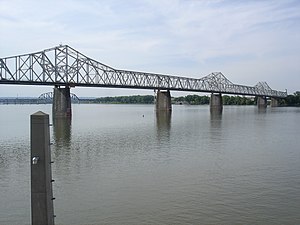George Rogers Clark Memorial Bridge | |
|---|---|
 The George Rogers Clark Memorial Bridge as seen from Louisville Waterfront Park | |
| Coordinates | 38°15′49″N 85°45′05″W / 38.26361°N 85.75139°W |
| Carries | 4 lanes of |
| Crosses | Ohio River |
| Locale | Louisville, Kentucky, and Jeffersonville, Indiana |
| Other name(s) | Second Street Bridge |
| Named for | George Rogers Clark |
| Maintained by | Kentucky Transportation Cabinet |
| Preceded by | John F. Kennedy Memorial Bridge |
| Followed by | Fourteenth Street (L&I) Bridge |
| Characteristics | |
| Design | Cantilever bridge |
| Material | Steel |
| Pier construction | granite backed by concrete |
| Total length | 5,746.5 ft (1,751.5 m) |
| Width | 38.0 ft (11.6 m) |
| No. of spans | 7 |
| Piers in water | 6 |
| Clearance below | 72.6 ft (22.1 m) at middle of channel span when river is at pool stage, or "normal" level |
| History | |
| Designer | Ralph Modjeski and Frank M. Masters |
| Constructed by | Vang Construction Company (piers) and American Bridge Company (superstructure) |
| Construction start | June 30, 1928 (first caisson launched) |
| Construction cost | $4.8 million |
| Opened | October 31, 1929 |
| Location | |
 | |
Louisville Municipal Bridge, Pylons and Administration Building | |
| Built | 1928 |
|---|---|
| Architect | Multiple |
| Architectural style | Art Deco, Warren through truss |
| NRHP reference No. | 84001578[1] |
| Added to NRHP | March 8, 1984 |
The George Rogers Clark Memorial Bridge, known locally as the Second Street Bridge, is a four-lane cantilevered truss bridge crossing the Ohio River between Louisville, Kentucky, and Jeffersonville, Indiana, that carries US 31.
